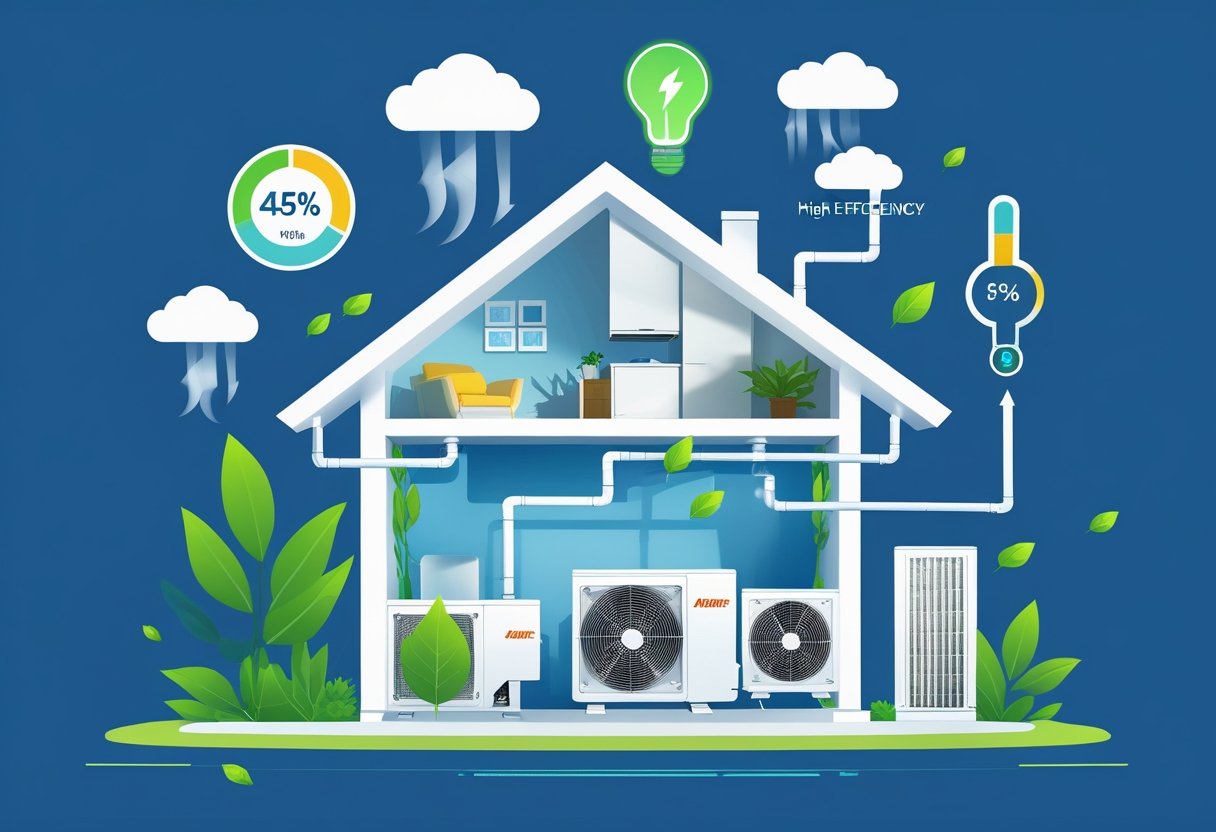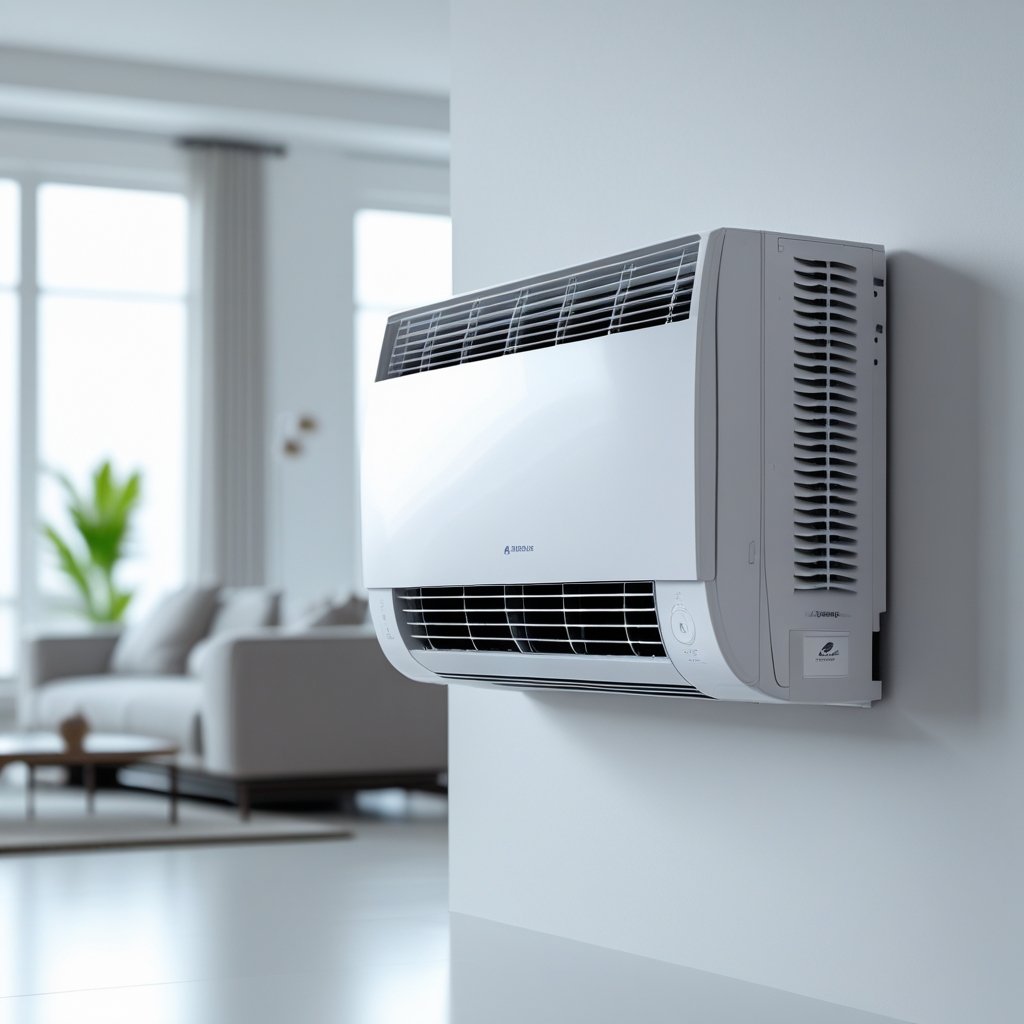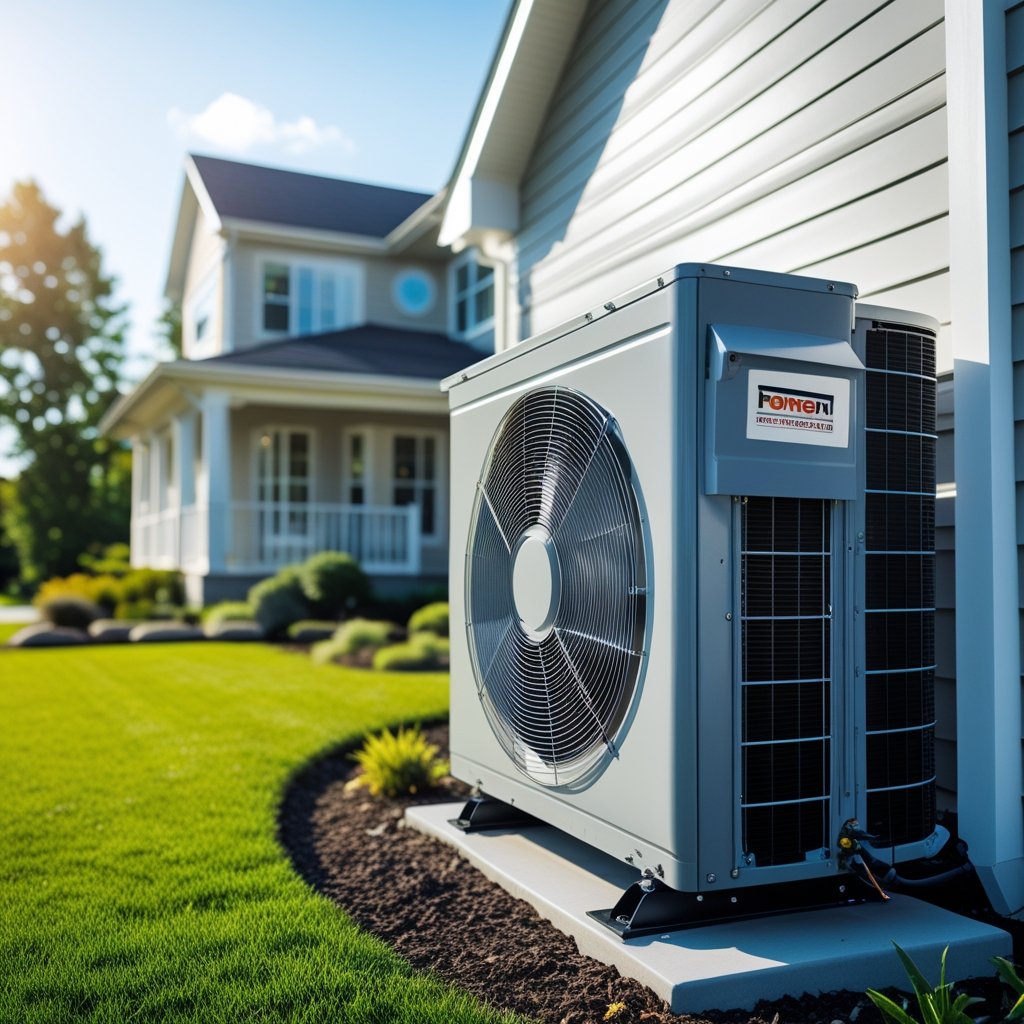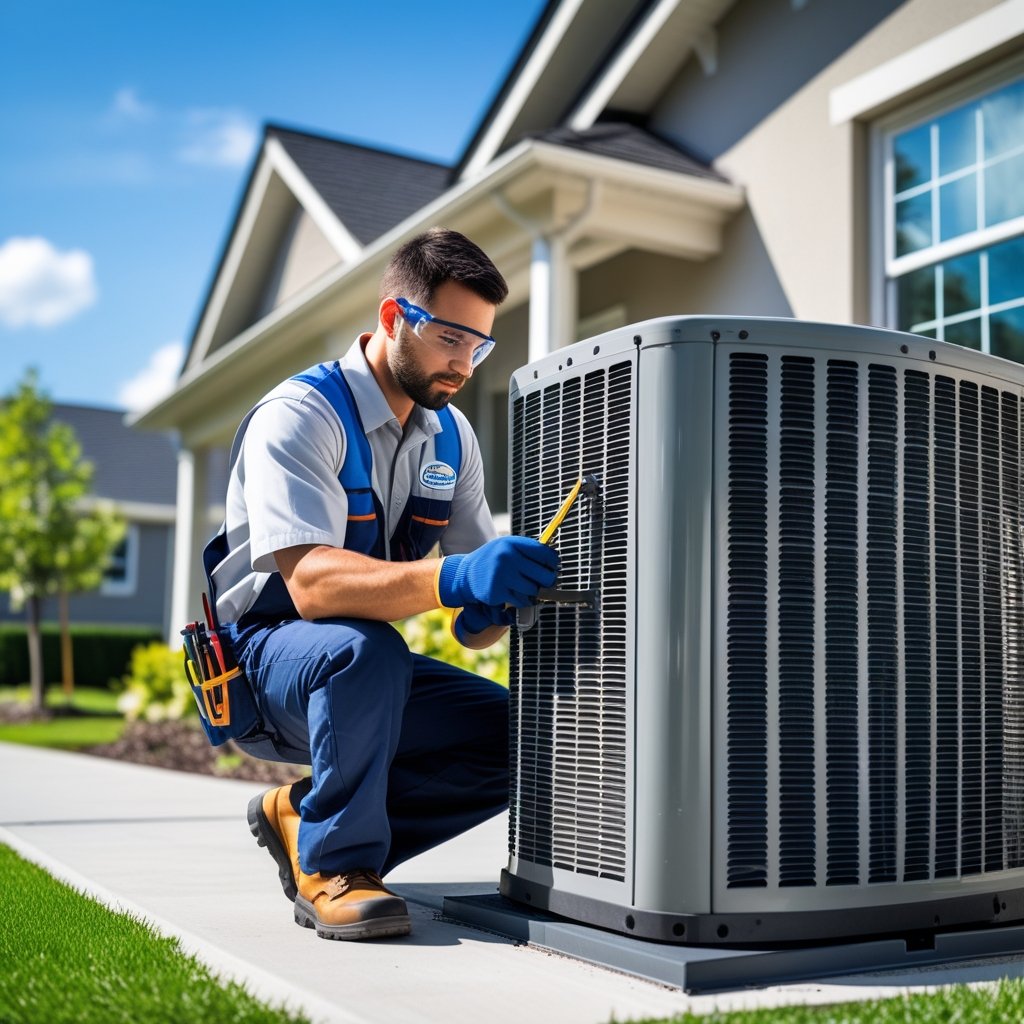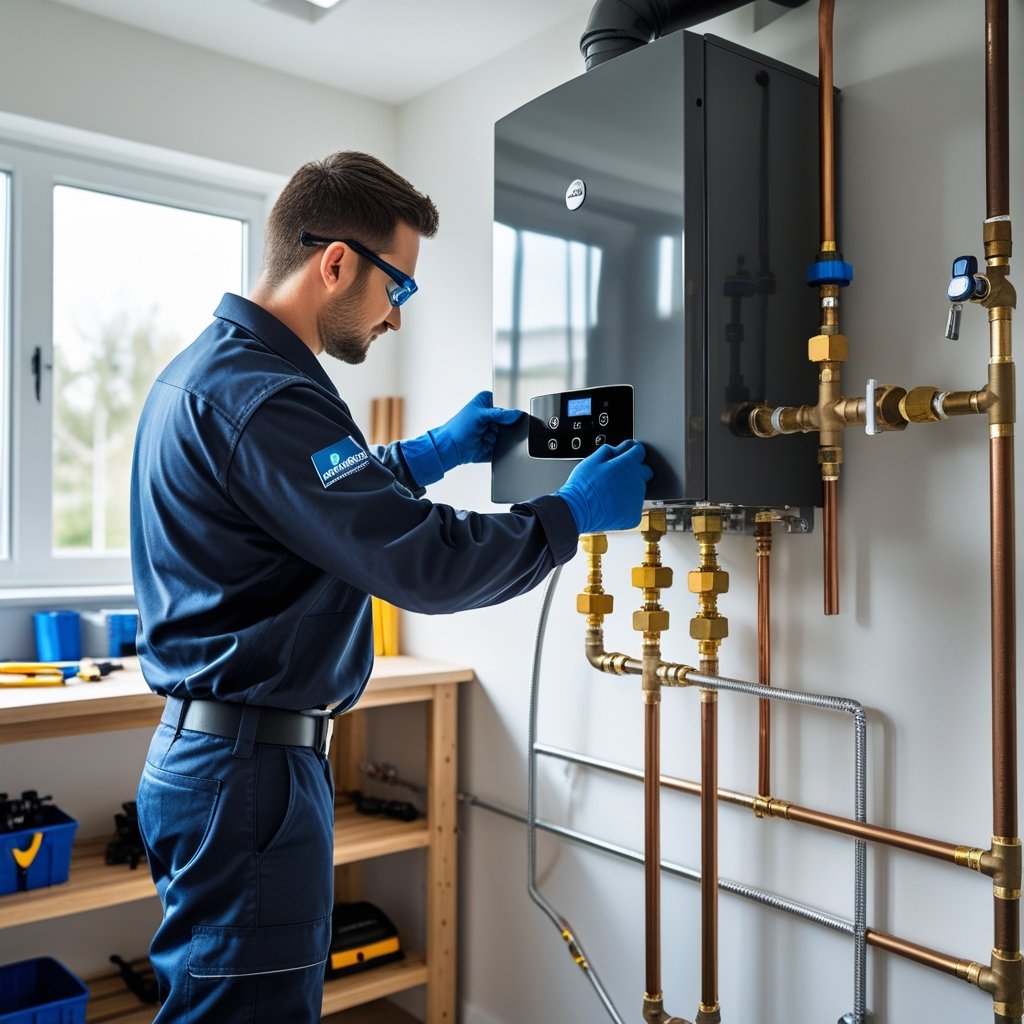If you’re thinking about upgrading your home’s heating and cooling, you might wonder if mini-split systems are more efficient than traditional options. Mini-split systems use advanced heat pump technology that can save you up to 40% on energy costs, making them a smart choice for year-round comfort. These systems give you precise zone control, so you only heat or cool the rooms you actually use, which helps cut down on wasted energy.
At Leo Kob Co., we’ve watched mini-split installation make a real difference for homeowners in South Central Pennsylvania—better comfort, lower bills. They run quietly and skip the ductwork, so installation’s often easier and there’s less energy lost along the way. If you care about efficiency and want more control, mini-splits are definitely worth considering.
Understanding Mini Split Systems
Mini split systems let you control heating and cooling in specific areas of your home. They use less energy than traditional systems because they only focus on the zones you’re actually using. So, you save money and stay comfortable all year.
What Are Mini Splits?
Mini splits are heating and cooling systems that don’t need ductwork. They include an outdoor compressor and one or more indoor air handlers. Each air handler runs separately, so you can heat or cool different rooms as you like.
Since they skip ducts, mini splits avoid the energy loss that plagues ducted systems. That makes them especially handy for homes without ducts or for new additions.
How Mini Splits Work
Mini splits move heat using refrigerant. In cooling mode, they pull heat from inside your home and send it outside. When heating, they do the opposite—drawing heat from outside air and bringing it in.
The indoor units usually go high on the wall or ceiling to spread air around evenly. You control each unit with a remote or your phone, dialing in the temperature exactly where you want it.
Types of Mini Split Systems
There are two main types: single-zone and multi-zone.
- Single-zone systems connect to one indoor air handler—great for a single room or small area.
- Multi-zone systems hook up to several indoor units, so you can control multiple rooms on their own.
Both types offer energy-efficient heating and cooling, but multi-zone systems are more flexible for bigger homes or if you want to condition several spaces.
Leo Kob Co. handles installation and maintenance to keep your mini split running its best. We serve South Central Pennsylvania and can help you pick what fits your home.
Energy Efficiency of Mini Split Systems
Mini-split systems use smart tech to heat and cool spaces more precisely than old-school systems. You get control over specific rooms, so there’s less wasted energy. Here’s how their efficiency is measured, why inverter technology matters, and how they stack up against central HVAC.
SEER Ratings and Mini Splits
SEER stands for Seasonal Energy Efficiency Ratio. It measures how efficiently an air conditioner cools over a season. Mini-split systems often hit SEER ratings above 20, which beats most central AC units.
Higher SEER means better efficiency, so mini splits use less electricity to keep you comfy—especially during those muggy months. If you’re in South Central Pennsylvania, a mini-split with a high SEER rating can save you money and energy all year.
Look for the Energy Star label when you’re shopping. That means the system meets strict energy efficiency standards.
Inverter Technology Advantages
Mini splits use inverter technology to adjust compressor speed. Instead of flipping on and off like older systems, they run at variable speeds to match what you need.
That means steady comfort without big energy spikes. No more wild temperature swings or wasted power during start-up.
Inverter tech also keeps things quieter, which most people appreciate. Plus, it cuts down on wear and tear, so your system lasts longer and breaks down less.
We at Leo Kob Co. often suggest mini splits with inverter tech for South Central PA homes—steady savings and solid reliability.
Energy Savings Compared to Central HVAC
Mini splits let you heat or cool individual zones, so you only use energy where it’s needed. This zone control can cut energy use by up to 40% compared to central HVAC systems that run the whole house at once.
You can turn off units in empty rooms, unlike central air that conditions everything whether you’re using it or not.
Mini-splits also dodge the energy losses from ductwork. Duct leaks or bad insulation in central systems can waste 20–30% of your heating or cooling energy. Mini splits send air straight to the room, so you don’t lose all that energy.
If you’re after comfort and lower energy costs, mini splits are a strong option. Reach out to Leo Kob Co. for mini-split installation and help with rebates in your area.
Comparing Mini Splits to Traditional HVAC Systems
Picking a heating and cooling system isn’t easy. You want to know what’ll work for your house and your needs. Efficiency, control, and climate performance are big factors to think about before you decide.
Ductless vs. Ducted Efficiencies
Mini splits are ductless, so they don’t lose energy through leaks like ducted systems do. Traditional systems can lose up to 30% of their energy through ducts—especially if those ducts are old or leaky. Mini splits push air right into the room, keeping the energy where you want it.
So, mini splits often use less electricity to heat or cool your space. That can lower your bills. But if your home already has well-installed ducts, a traditional system might still be efficient—as long as you keep up with maintenance.
Zoned Cooling and Heating Benefits
Mini splits let you set the temperature in each room on its own. No more wasting energy heating or cooling empty spaces. You only run the system in the rooms you’re actually using, which saves money.
Most traditional HVACs control your whole house from a single thermostat. That causes uneven temps and higher energy use—you might end up heating or cooling rooms nobody’s in.
Zoning with mini splits gives you better comfort, too. You can set different temps for bedrooms, living rooms, or your office, depending on who likes what.
Performance in Various Climates
Mini splits work well in moderate to cold climates because their heat pump tech can heat and cool efficiently. Even when it’s cold out, many models keep your house warm without extra heaters.
In really hot and humid areas, mini splits still perform, though their efficiency might dip a bit during extreme heat. If your home already has a duct system built for high humidity, a traditional HVAC might do the trick.
For South Central Pennsylvania—cold winters, warm summers—mini splits deliver solid year-round efficiency. We at Leo Kob Co. recommend them for folks looking to save energy and enjoy flexible temperature control.
Give us a call if you want to talk mini-split installation in Elizabethtown or nearby. We’ll help you find the right fit for your home and your budget.
Factors That Affect Mini Split Efficiency
A few key things shape how well your mini split performs: installation quality, matching system size to your home, and regular maintenance. Paying attention to these details helps you save energy and keeps your system humming along.
Installation Quality
Good installation is crucial for your mini split to run efficiently. Bad installs can cause leaks, weak airflow, or short cycling—all of which waste energy and can damage the system.
Pick a licensed, experienced installer. The techs at Leo Kob Co. know how to place indoor and outdoor units for the best airflow and control.
Common mistakes include wrong refrigerant charge and poor unit placement. These can drop efficiency by up to 30%, so you’ll pay more for energy and repairs.
A solid installation should include:
- Correct refrigerant levels
- Smart unit placement (not in direct sun, no obstructions)
- Tight, sealed ductless connections
- A clean, level setup for the outdoor unit
Sizing and System Selection
Getting the right size system matters. Too small, and it won’t keep up. Too big, and it’ll cycle on and off too much, wasting energy and wearing out faster.
Things like your home’s size, insulation, windows, and how many people live there all count when sizing a mini split. A pro can do a load calculation to get it right.
Leo Kob Co. gives expert advice to help you pick the best system for your home’s needs. That way, your mini split runs efficiently for both heating and cooling.
Maintenance Impact
Regular maintenance keeps your mini split efficient for years. Dirty filters, clogged coils, or low refrigerant can all drag down performance and drive up your bills.
Clean or replace air filters every month, and keep the outdoor unit clear of debris. Annual tune-ups from a licensed tech make sure refrigerant levels and parts are in shape.
Skip maintenance, and you could lose 15–20% efficiency and shorten the system’s life. Yearly checkups with Leo Kob Co. help you avoid pricey repairs and keep things running smooth.
Long-Term Cost Savings With Mini Splits
Mini split systems can save you money over time in a few ways. They cut utility bills and tend to last longer than many traditional units. The return on investment is clear—especially if you go with good installation and maintenance.
Lower Utility Bills
Mini splits are built to use less energy than old heating and cooling systems. Since they don’t use ducts (which often leak), more of the energy goes straight into heating or cooling your home.
You can also set the temperature in each room separately. That means you’re not wasting energy on empty spaces, which keeps your energy use down.
In South Central PA, homes with mini splits usually see 20–30% lower utility bills. Your savings depend on your home and local rates. Leo Kob Co. can help you pick a system that’ll get you the most savings.
Lifespan and Durability
Mini splits usually last longer than traditional HVAC. With care, they’ll run well for 15 to 20 years. Central air or heating units often need replacing after 10 to 15 years.
Since mini splits don’t push air through long ducts, there’s less wear and tear. Their parts are also easier to maintain or swap out. Regular maintenance keeps them efficient.
Quality installation helps, too. Leo Kob Co., with over 100 years of experience, focuses on durable work—so your system lasts longer and you spend less on repairs.
Return on Investment
The upfront cost of a mini split is usually higher than a basic furnace or AC. But the long-term savings often make up for it.
Energy efficiency rebates in Pennsylvania can help with the initial price. The savings on your bills add up—often covering the cost in just a few years.
If you’re planning to stay in your home for a while, a mini split pays off. The durability and monthly savings give you real value over time. It’s worth thinking about when you’re upgrading your HVAC.
Call Leo Kob Co. if you want to chat about mini split installation and how you can start saving in your South Central Pennsylvania home.
Environmental Impact and Sustainability
Mini split systems can help you cut energy use and handle refrigerants in a cleaner way. Knowing how they reduce emissions and use eco-friendlier materials lets you make smarter choices for your home and the planet.
Reducing Your Carbon Footprint
Mini splits use less energy than a lot of traditional heating and cooling systems. They only heat or cool the rooms you’re actually using, instead of running for the whole house all the time. This targeted approach means lower electric bills and fewer carbon emissions.
Since they run on electricity, mini splits can pair up with renewables like solar panels—shrinking your carbon footprint even more. If you’re in South Central Pennsylvania, Leo Kob Co. can help set up your mini split for top efficiency and savings.
Use of Eco-Friendly Refrigerants
Mini split systems today use refrigerants that are much safer for the environment than the old ones. Most newer models run on R-410A or similar options that don’t harm the ozone layer. These refrigerants tend to leak less, burn cleaner, and just have a lower impact overall.
If you want to avoid refrigerant leaks, it’s important to take care of your mini split system. Leo Kob Co. suggests regular maintenance to keep everything working well and to help the environment at the same time. That way, your system lasts longer and your home’s footprint stays small.
Ideal Homes and Applications for Mini Splits
Mini split systems really shine in homes where you care about zoning and flexible climate control. If you want to set different temperatures in different rooms and not waste energy heating or cooling places you’re not using, these are a solid choice.
Best Settings for Maximum Efficiency
You’ll get the most out of a mini split if you use it in rooms that need targeted heating or cooling—think bedrooms, home offices, sunrooms. Each unit can be adjusted separately, so you’re not running a big central system all day for no reason.
They’re a good fit for homes with decent insulation and sealed windows. If your place holds in air pretty well, the mini split won’t have to work as hard to keep things comfortable.
Adding a programmable thermostat can help too. You can set different temps for when you’re not using certain rooms and save even more energy. Leo Kob Co. usually recommends pairing mini splits with smart controls for the best results.
Retrofitting Older Homes
Older homes without ductwork? Mini splits are a lifesaver. Installing ducts is pricey and a hassle, but a mini split only needs a small hole for the line set, so setup’s way easier and less expensive.
They’re perfect for heating and cooling rooms that traditional systems just can’t reach—like additions or converted spaces. You can skip a full HVAC overhaul and still get comfort where you need it.
Got uneven heating or cooling? A mini split can balance things out without tearing up your house. In places like Lancaster or Harrisburg, where older homes are everywhere, it just makes sense. And if you want the job done right and affordable, you can trust Leo Kob Co..
Common Myths About Mini Split System Efficiency
People have a lot of questions—and honestly, some misconceptions—about how mini splits perform. There’s plenty of confusion out there about costs and maintenance. It’s worth sorting fact from fiction before you decide what’s best for your place.
Misconceptions on Running Costs
Some folks think mini splits are more expensive to run than traditional HVAC. Actually, they usually use less energy since you’re only heating or cooling the rooms you want. That zone control really helps shrink your bills.
There’s also this idea that mini splits come with hidden costs, like constant repairs or pricey parts. But if you get a good install and keep up with yearly maintenance, your costs should stay steady and reasonable.
You shouldn’t see any wild surprises on your electric bill. Leo Kob Co. suggests a check-up every year to keep things running smooth and efficient.
Noise and Maintenance Myths
A lot of people assume mini splits are noisy, but that’s not the case. Most models are super quiet. The outdoor unit just hums, and the indoor units are built for gentle airflow.
Another one: some think mini splits need a ton of upkeep. Actually, cleaning the filters and scheduling an annual inspection is about all it takes. No complicated or expensive maintenance needed.
If you’re in South Central Pennsylvania, Leo Kob Co. can help with expert installation and service to keep your mini split reliable and quiet.
Frequently Asked Questions
Mini split systems often save energy and give you flexible temperature control. They can work well in cold weather and can both heat and cool your home efficiently. Some models have very high SEER ratings, but there are a few things to consider before choosing a mini split over other systems.
What are the efficiency differences between mini splits and central air systems?
Mini splits typically use less energy because they cool or heat only the rooms you're using. Central air systems cool or heat the whole house, which can waste energy in unused spaces. Mini splits also avoid energy loss from ductwork.
How do mini splits perform in extremely cold conditions?
Some mini splits are designed to work well even when it’s very cold outside. They can still provide heat efficiently, but performance may drop in freezing weather. Your technician can help pick a model suited for cold climates like South Central Pennsylvania.
Can mini splits provide efficient heating as well as cooling?
Yes, mini splits offer both heating and cooling. They use heat pump technology to transfer heat instead of creating it, which saves energy. This makes them a good option for year-round comfort.
What is the highest SEER rating available for mini splits?
Many mini splits have SEER ratings between 20 and 30, which is higher than most central air units. A higher SEER means better energy efficiency. Ask your HVAC specialist about models with the best ratings for your home.
Are there any downsides to using a mini split system?
Mini splits can cost more upfront than window units or central systems. They may require professional installation to work right. Some people find the indoor units less attractive compared to hidden vents. Regular maintenance is important to keep efficiency high.
How does a mini split system's efficiency compare to that of window units?
Mini splits usually use less energy than window units. They're quieter, more efficient, and honestly, they just handle temperature control better. Window units tend to cycle on and off with some noise, while mini splits can heat a room and keep things steady—without all that racket.
If you're in South Central Pennsylvania and thinking about a mini split, Leo Kob Co. has licensed techs who actually know what they're doing. They focus on quality work and want you happy in the long run.

